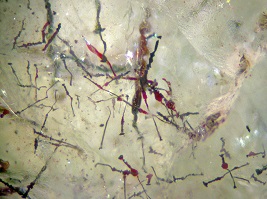
Locality: Gilman Notch, Center Ossipee, NH
Specimen Size: 5 mm fov. Hematite needles embedded in quartz.
Field Collected: Jon Herndon - 2008
Catalog No.: 1948
Notes: Gift from Brad Lewis. This specimen is from the "Surprise Pocket". See article by Herndon & Green Rocks and Minerals Mar./Apr. 2011, pgs 168-173.
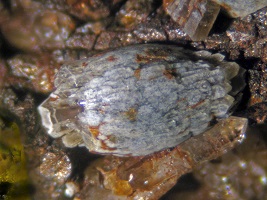
Locality: Palermo Mine, N. Groton, NH
Specimen Size: 4 mm barrel-shaped, pinecone crystal cluster
Field Collected: Forrest Fogg -1973
Catalog No.: u1561
Notes: A polished grain EDS analysis from an adjacent broken crystal group suggested childrenite. Calcium is not present in the childrenite formula, so the modest Ca peak in the spectrum is somewhat bothersome. (The large spectral peak at the lowest end of the spectrum is due to the carbon coating.) I have not previously seen the pinecone shape and pale-blue coloration in childrenite.
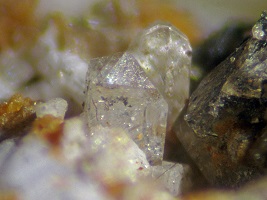
Locality: Chickering Mine, Walpole, NH
Specimen Size: 0.9 mm brazilianite crystal
Field Collected: Tom Mortimer
Catalog No.: TBC
Notes:
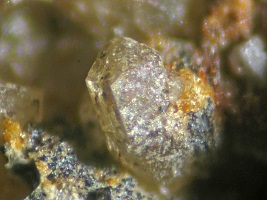
Locality: Chickering Mine, Walpole, NH
Specimen Size: 0.7 mm brazilianite crystal
Field Collected: Tom Mortimer
Catalog No.: TBC
Notes:
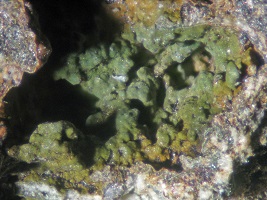
Locality: Chickering Mine, Walpole, NH
Specimen Size: 4 mm field of view
Field Collected: Tom Mortimer
Catalog No.: u1733
Notes:
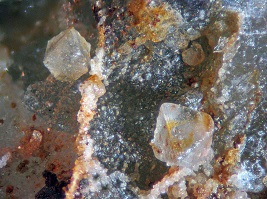
Locality: Chickering Mine, Walpole, NH
Specimen Size: Pair of wardite crystals. Largest is 0.7 mm
Field Collected: Tom Mortimer
Catalog No.: u1696
Notes: Photo from stack of 18 images, 0.05 mm steps, processed with Helicon Focus.
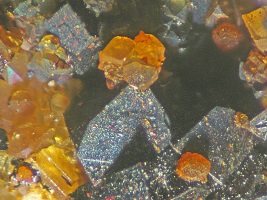
Locality: Chickering Mine, Walpole, NH
Specimen Size: 1.2 mm field of view. Orange second generation siderite rhombs on black earlier generation of siderite.
Field Collected: Tom Mortimer
Catalog No.: u1677
Notes: Photo from stack of 9 images, 0.04 mm steps, processed with Helicon Focus.
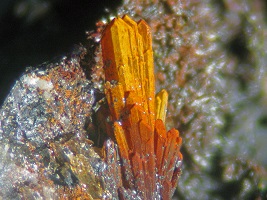
Locality: Chickering Mine, Walpole, NH
Specimen Size: 3 mm cluster of oxide coated childrenite crystals.
Field Collected: Tom Mortimer
Catalog No.: u1724
Notes: Photo from stack of 18 images, 0.05 mm steps, processed with Helicon Focus.
At the Chickering Mine, when childrenite is found in weathered siderite vugs, it is frequently coated with an orange oxide.
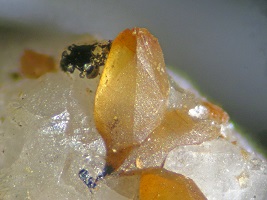
Locality: Palermo Mine, N. Groton, NH
Specimen Size: 1.1 mm hydroxylherderite crystal
Field Collected: Forrest Fogg
Catalog No.: u1760
Notes: The crystal termination is a group of small pyramids.
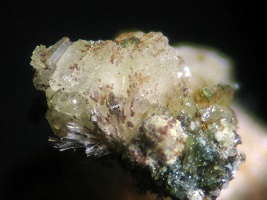
Locality: Joppa Hill Locale, Amherst, NH
Specimen Size: 4 mm field of view. Cluster of blocky chabazite-(Ca) crystals with dendritic patterns on surface.
Field Collected: Tom Mortimer
Catalog No.: u484
Notes: A polished grain EDS analysis was consistant with a chabazite-(Ca) identification, (the large spectral peak below oxygen is due to the carbon coating of the sample). This is the first report of chabazite at the Joppa Hill Locale. It is unknown how common the occurrence chabazite is in a skarn environment. The small cluster of acicular crystals in the lower left may be another zeolite species.
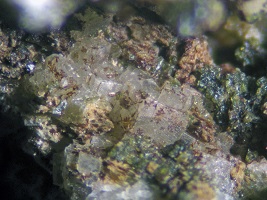
Locality: Joppa Hill Locale, Amherst, NH
Specimen Size: 4 mm field of view. Cluster of blocky chabazite-(Ca) crystals with dendritic patterns on surface.
Field Collected: Tom Mortimer
Catalog No.: u489
Notes: Thin, short prismatic, zoisite crystals are present on most of the specimens with chabazite, along with the common Joppa Hill minerals grossular and diopside. The green mineral appears to be a mica group species.
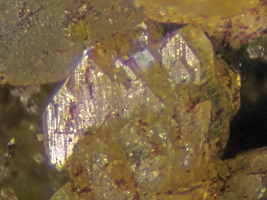
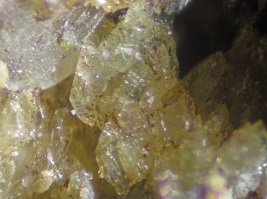
Locality: Joppa Hill Locale, Amherst, NH
Specimen Size: 1.3 mm field of view. Cluster of zoisite crystals.
Field Collected: Tom Mortimer
Catalog No.: u487
Notes: Two views. Top view maximizes the reflection from the prism faces to enhance the striations, (at the expense of accurate color rendering). The lower photo reproduces the pale greenish-yellow color of these crystals.
A polished grain EDS analysis was consistant with a zoisite identification, (the large spectral peak below oxygen is due to the carbon coating of the sample). The element chemistry of zoisite: Ca2Al3Si3O12(OH) is not that different from chabazite-(Ca): (Ca,K2,Na2)2[Al2Si2O12]2 · 12H2O , when K and Na substitution are absent.
Since zoisite and clinozoisite are dimorphs, a XRD analysis is required to differentiate these two species. The steep termination biases my [tm] opinion to zoisite.